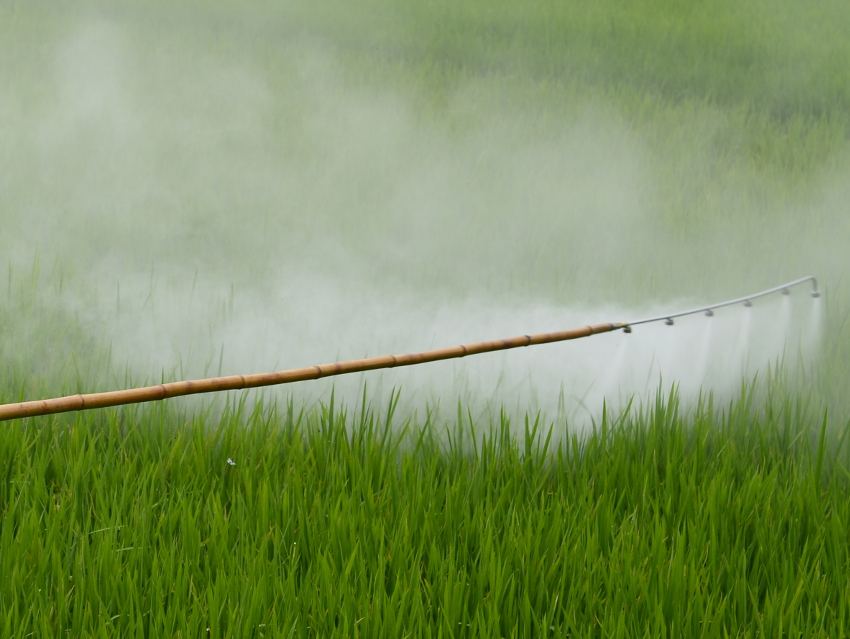Sweet Death of Plants
Stephanie Grond, Karl Forchhammer, and colleagues, University of Tübingen, Germany, have discovered a cyanobacterial antimetabolite that acts as a potent herbicide. The compound is a seven-carbon-atom sugar molecule, a heptulose. It does not look spectacular, but turned out to effectively inhibit an enzyme in the shikimate pathway, which is essential for plant growth. In its herbicide action, the cyanobacterial natural product clearly outcompeted glyphosate and, thus, holds promise for applications in agriculture.
Roundup’s Round-Up Discussion
One of the most widely used herbicides is glyphosate, also known under the brand name Roundup. It has herbicidal activity because, as a competitor of phosphoenolpyruvate, it inhibits one of the enzymes in the shikimate pathway that supplies plants, fungi, and many microorganisms with aromatic amino acids. As animals do not have this pathway (and, therefore, rely on plants, microorganisms, and fungi for their supply of aromatic amino acids), they are not thought to be affected by glyphosate.
But are they really not affected? In recent years, a bitter discussion has emerged on whether glyphosate might be cancerous and how it affects the microbiome of honey bees and contributes to the decline of bee populations. However, what is known after 65 years of usage is that glyphosate persists in the environment unexpectedly long, and can be detected almost everywhere by now.
An Unspectacular Looking Natural Sugar
Although soil bacteria are known to produce a variety of secondary metabolites, cyanobacteria, the presumed precursors of the plants’ chloroplasts, are less recognized for their supply of biologically active compounds. Therefore, when microbiologist Klaus Forchhammer asked one of his students to check the dried supernatant of a culture of a rather simple standard cyanobacterium for biological activity, he did not expect anything spectacular.
But the researchers were surprised to find that it did indeed something remarkable: cells of another cyanobacterial species died in contact with the supernatant. The discovery was noted and then put aside. It was taken up again four years later, just out of curiosity. “We did not expect herbicide activity, not at all. We were just curious what kind of molecules were residing in the supernatant that showed this inhibitory activity,” Forchhammer explained his motivation to identify the substance.
The substance turned out to be a highly polar sugar. After it was separated and isolated using classical biochemical methods, it was eventually identified as 7-deoxy-sedoheptulose or, short, 7dSh. The researchers then tried to clarify its mode of action. As one of the intermediates of the shikimate pathway accumulated in a cell line sensitive to 7dSh, the team concluded that 7dSh inhibited the enzyme normally processing this intermediate. Therefore, they identified 7dSh as an antimetabolite blocking the shikimate pathway. This means it could be a potent herbicide.
The researchers compared the sugar’s biological activity with that of glyphosate. The results were impressive: It impeded the growth of Arabidopsis seedlings at much lower concentrations than glyphosate, but it was not toxic to mammal cell lines.
What about Effects on the Environment?
One of the most prominent side effects of glyphosate is its relatively long persistence in the environment. Another issue is its poor solubility and the fact that plants resorb glyphosate much better in combination with surfactants and additives. These “round-up” formulations are often believed to cause more harm than the pure compound itself.
Here, 7dSh has advantages because it is polar and soluble and can be easily taken up by plants, while any excess compound is washed off and degraded. “Of course, we do not have data yet. But we do believe that the substance must degrade relatively fast because cyanobacteria have produced it for many millions of years,” says Klaus Brilisauer, who conducted the purification and isolation of 7dSh.
Neglected Fractions in Focus
Indeed, 7dSh has gone almost unnoticed for decades of research on bacterial metabolites, although there is no reason to assume one freshwater cyanobacterium is the only strain producing the sugar. The team has an explanation for this oversight: “Antibiotics research usually looks for nonpolar metabolites, but the sugar was always in the most polar fraction that is normally discarded,” says Brilisauer. It literally fell through the sieve of natural product research.
This is likely to change. This research has shown that there might still be various interesting natural products residing in unexpected places and waiting to be discovered.
- Cyanobacterial antimetabolite 7-deoxy-sedoheptulose blocks the shikimate pathway to inhibit the growth of prototrophic organisms,
Klaus Brilisauer, Johanna Rapp, Pascal Rath, Anna Schöllhorn, Lisa Bleul, Elisabeth Weiß, Mark Stahl, Stephanie Grond, Karl Forchhammer,
Nat. Commun. 2019.
https://doi.org/10.1038/s41467-019-08476-8



